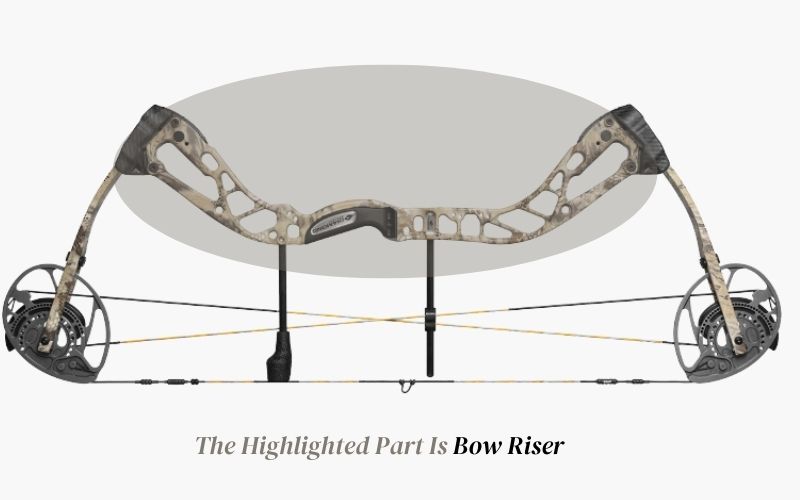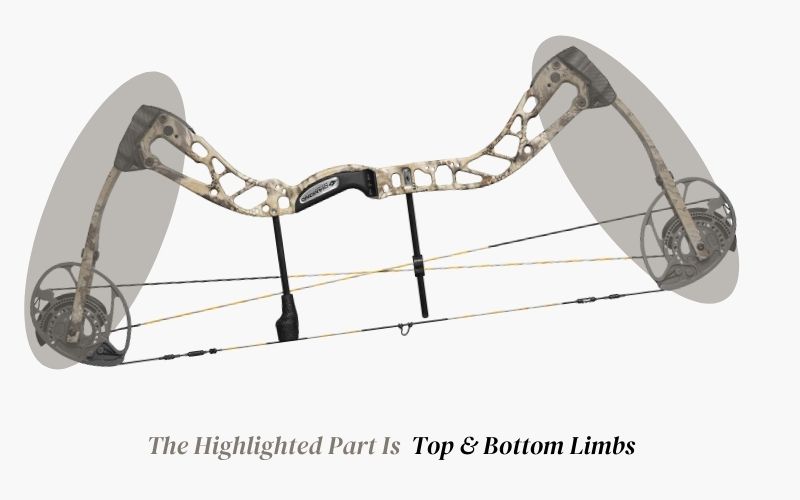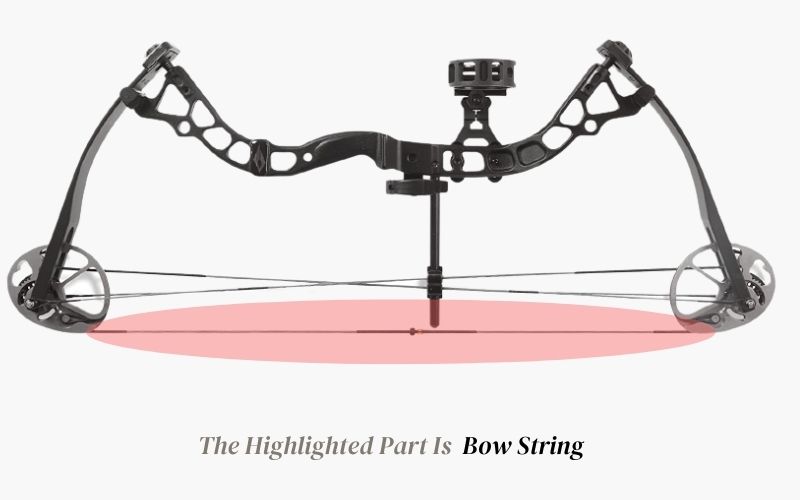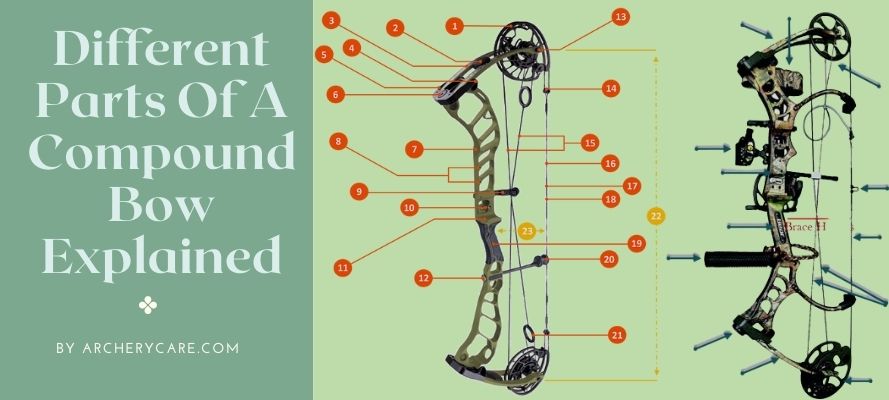Archery is all about precision. From ancient times it has been a prime weapon of defense, hunting, and attack. Your aim needs to be accurate and movements need to be very calculative here. The new and updated compound bow comes in handy at those times.
Whether you are a professional or an occasional archer, you need to be aware of your equipment. The parts of a compound bow are laid out in a pretty complex way.
So tag along with us as we explore all the compound bow parts and how they work. We will also share some additional info that will surely help you to have explicit knowledge about compound bows.
Table of Contents
- What Is a Compound Bow - Background and Other Details?
- What’s It Made of?
- 22 Compound Bow Parts Explained (compound bow parts diagram)
- Frequently Asked Questions
- What are the parts of the compound bow?
- What are the 4 parts of a bow?
- What is the thing that sticks out on compound bow?
- What part of the compound bow holds the arrow?
- What are the three main parts of a bow?
- What is the string part of a bow called?
- What is the handle of a bow called?
- What is the tip of an arrow called?
- What are the upper and lower parts of the bow called?
- What is the fluffy thing on a bow?
- What is the valley on a compound bow?
- What is the rod on a compound bow?
- What is the arrow rest on a bow called?
- What's the wood part of a bow called?
- What are the different parts of the bow and arrow?
- Final Verdict
What Is a Compound Bow - Background and Other Details?
A compound bow is a bow that uses a system of pulleys and cables to bend the limbs and store more energy than a recurve bow or longbow. This makes the compound bow much more efficient in terms of energy transfer, and therefore, it can shoot arrows much faster and with more accuracy than other types of archery bows.
The first compound bow was developed in the 1960s, and it quickly became popular with hunters and target shooters.
Today, compound bow is used by Olympic archers and is the most popular type of bow in the United States. But this bow ain't allowed in the Olympics officially.
These bows are typically very adjustable, which makes them suitable for both beginners and experienced shooters. The draw weight (the amount of force needed to draw the bowstring back) can be adjusted, as can the draw length (the distance the bowstring is drawn back).
Compound bows are generally more expensive than other bow types, but they are also more efficient and easier to use. If you are serious about Archery, a compound bow is a great investment.

What’s It Made of?
Compound bows are typically made from a mixture of materials, including wood, fiberglass, carbon fiber, and aluminum. The limbs are usually made from fiberglass or carbon fiber, while the riser (the center portion of the bow) is typically made from aluminum.
22 Compound Bow Parts Explained (compound bow parts diagram)

As a compound bow’s construction is rather complex than you might think. In order to use these bows with efficiency, one should have precise knowledge about the parts of a compound bow. So, here are the detailed descriptions of all the parts-
1. The Riser
The most important part of the compound bow is the riser, which is the central portion of the bow that the other parts are attached to. All other subsidiary parts attach to this mother part.
The riser is typically made of aluminum or magnesium, which makes it very strong and lightweight.

2. Top and Bottom Limbs
The limbs are attached to the riser at the top and bottom, and they are usually made of composite materials such as carbon fiber or fiberglass.
These materials are very strong and lightweight, which will ensure you have a much more energy-efficient compound bow.

3. Limb Bolts
A limb bolt is a type of bolt that is used to attach the limb pocket of a compound bow to the riser. The bolt is inserted through the limb and into the riser and then adjusted with an Allen key in place. Tightening and loosening the bolts increases and decreases the draw weight.
4. Limb Pocket
Limb pockets are the area of a compound bow where the limbs attach to the riser. The pocket is a critical component of the bow, as it helps to transfer energy from the limbs to the arrow and ultimately the target. A well-designed pocket will minimize vibration and help you to shoot more accurately.
5. Top and Bottom Cams
A cam is a rotating wheel with an eccentric shape. In a compound bow, the cams are attached to the ends of the limbs and transfer the energy of the bowstring to the arrow. There are two main types of cams: single and dual.
Single cams have one wheel, while dual cams have two. Dual cams are more efficient than single cams because they provide a more even distribution of energy. However, they are also more difficult to tune.

6. Bowstrings

Another important part of the compound bow. The string is what actually propels the arrow forward, and it is typically made of para-aramid fibers such as Kevlar or Spectra.
It’s attached to the riser at both ends of a bow, and it runs through the pulleys and cables of the compound system. A durable string can affect your performance quality in a greater depth.
7. String Silencer
A string silencer is a device that is attached to the string of a compound bow in order to reduce the amount of noise that the string makes when it is fired. There are a variety of different types of string silencers available on the market. The best of them can reduce the noise by up to 90%.
8. Cable Slides
A cable slide is a device that is installed on a compound bow. It is used to help keep the bowstring in alignment. The cable slide also reduces friction and wear on the bowstring, by allowing it to slide smoothly through the grooves.
The cable slide is mounted on the bowstring, and the bowstring is passed through it. The cable slide has a series of grooves that the bowstring rests in. As the bowstring is drawn, the cable slide slides along the bowstring, keeping it in alignment.
9. Cable Rod
A cable rod is a piece of equipment that is used to help stabilize the cables on a compound bow. The purpose of the cable rod is to keep the cables aside from the bow’s center and to help keep the bow in a more consistent position. The cable rod is usually made out of aluminum or steel and is placed in the middle of the bow.
10. D Loop
A D-Loop is a string loop that is attached to the bowstring with a Cinch knot. The D-Loop helps to anchor the bowstring to the bow, which in turn will help you with a more consistent and accurate shot. Many archers prefer to use a D-Loop because it helps to reduce hand shock or the vibration that is felt in the hand when the bow is fired.
11. Serving
Serving is the process of applying a protective layer of braided thread to the point of the bowstring where the archer would nock the arrow. This layer helps to reduce friction and wear to protect the string from abrasion. The serving area is also the area where the archers put the D Loop.
12. Grip
The grip is the part of the compound bow that the archer holds onto. It is typically made of rubber or leather, and it is located on the riser. This part will help you keep your hand from slipping, and it also helps to absorb the vibration of the bow.
13. Axle Pins
The axle is a very crucial part especially which is used for targeting long-distance things. We all know that the cams need to turn while preparing shooting. Axle pins are the accessories that make this happen. This makes the cams turn in different positions.
Maybe you are thinking that they bear the hind and front points of the bow. The total distance between the hind and front
The axle of a compound bow is named 'axle-To-Axle' distance.
14. Dampener
All the compound bows are functional with a few dampening systems. Some of them are working into the riser; on the other hand, some of them are put in the middle of the two limbs. The function of a dampener is too simple. It eliminates the extra noise and the unwanted vibration that makes you lose your concentration.
15. Buss Cable
This cable is a wholly separate cable that is attached to the Axle of the Cams. The main purpose of the Buss Cable is to synchronize the speed of the cams or idle wheel with the bowstring as the bowstring gets pulled for firing. With this, you’ll have a symmetrical speed while shooting an arrow.
16. Bow Sight
The sight is a device that is used to aim the compound bow. This tool is typically mounted on the riser, and it has a series of pins that are used to line up the shot. You can either fix or adjust it as your requirement, and it is an important part of the compound bow that will help you to be more accurate.
17. Quiver
It’s a device that is used to hold the arrows. The quiver is typically mounted on the riser or on the bow's limb. And it uses construction materials such as leather, nylon, or plastic.
This tool will keep your arrows organized and protected, and also, it comes in super handy to transport the arrows to and from the shooting range.
18. Peep sight
This is the tiny, shallow appearance from which you look through when you are aiming. This helps you to install the draw carefully and perfectly at a time. Through this small part, you can make good results at aiming. Especially when you are aiming at anything from a distance, it is a must.
19. Arrow Rest
When you knock the arrow there should be a function to rest it. This small part comes in different patterns. If you are a beginner then you must use this feature as it helps you to aim correctly.
Our recommendation is the drop-away move.
You have to keep the bow on your hand as well as offhand. Here come the grips to help you with this problem. You can hold the bow offhanded with the help of a grip knob. But when you use it for a low distance you should cut off the front grip. And use some tape instead of this. Because some grips are so big, we don't feel comfortable with them.
20. Stabiliser
The stabilizer is a device that is used to help the archer to hold the bow steady which is typically mounted on the riser. It can be made of different materials such as aluminum, carbon fiber, or fiberglass. It helps to reduce the vibration of the bow, and it will also back you up in keeping the bow from moving around when the archer is drawing the bowstring.
21. Release
The release is a device that is used to release the arrow from the bow. It’s typically mounted on the riser or on the bow's limb, and it can be made of different materials such as aluminum, plastic, or leather.
The release helps to keep the arrow from moving around when the archer is drawing the bowstring, and it also helps to prevent the arrow from bouncing off of the bow when it is released.
Frequently Asked Questions
What are the parts of the compound bow?
The compound bow is a highly sophisticated piece of equipment, and understanding its parts can enhance your archery experience. The riser forms the central section of the bow and houses the grip, providing stability as you hold and aim the bow. Next, the limbs are vital components, connecting to the riser and flexing to store energy. The bottom cam, part of the cams, assists in controlling the draw force curve, while the bowstring connects the bow's limbs, allowing you to draw and release arrows.
Furthermore, cables are responsible for synchronizing the movement of the limbs, and the cable guard and cable slide guide and protect these cables. Lastly, the containment arrow rest or simply arrow rest serves to guide the arrow and hold it in place before the shot. From my personal experience in archery, understanding these elements and how they work together can make a tremendous difference in your shooting accuracy and enjoyment.
What are the 4 parts of a bow?
The bow, a timeless instrument used for archery and hunting, comprises four main parts. The riser, the center piece of the bow, is where the upper and lower limb attach, giving you a firm grip. Limbs, both upper and lower, are essential as they hold and release the energy when you draw the bow. At the tip of each limb, there's a groove known as the string nock, which holds the bowstring. Finally, the string is what you draw back to shoot an arrow.
In addition to these, arrows themselves have various parts, including the point, shaft, fletching, and nock. As an avid archer, I can attest to the importance of each part and how understanding them can contribute to improving your technique.
What is the thing that sticks out on compound bow?
If you've ever observed competitive archery or bowhunting, you may have noticed long objects protruding from the front of the bows. These are known as stabilizers, and they play an essential role in enhancing the bow's stability during the shot. Stabilizers come in various sizes and weights, and their main function is to balance the bow and reduce vibrations. From my competitive archery days, I remember how adding a stabilizer to my bow improved my accuracy and overall control.
What part of the compound bow holds the arrow?
In the world of archery, the part of the compound bow that holds the arrow is known as the rest. Specifically, the arrow sits on the rest, located in the area of the riser called the arrow shelf. While the rest holds the arrow off the shelf on compound bows, traditional bows usually have the arrow resting directly on the shelf. During my time coaching beginners, I've seen how proper understanding and adjustment of the arrow rest can lead to better alignment and accuracy.
What are the three main parts of a bow?
A bow, whether it's a traditional longbow, recurve bow, or more technologically advanced compound bow, generally consists of three main parts: a string, limbs, and a grip. The string is what's drawn back to shoot, the limbs store the energy, and the grip helps you hold the bow steady. In my years of crafting custom bows, the art of combining these three essential components to create a balanced and efficient tool has always fascinated me.
What is the string part of a bow called?
The string part of a bow is aptly called the bowstring. It's a high-tensile cord that attaches to the limbs of a longbow or recurve bow or to the cable in the case of a compound bow. The bowstring also features a center nock locator, helping in positioning the arrow. As someone who has replaced many bowstrings, I can tell you that selecting the right material and maintaining the string's condition are crucial to the bow's performance.
What is the handle of a bow called?
The handle of a bow, a vital part where the archer grips the bow, is known as the riser. It's also sometimes referred to as the "Handle" of a bow. Additionally, there's a "Serving" area, which is the thread wrapping on the bowstring where the nock set resides. I remember my first custom-made bow, where the riser was crafted to fit my hand perfectly, making a significant difference in my comfort and accuracy.
What is the tip of an arrow called?
The tip of an arrow is known as the arrowhead. Arrowheads come in various types, each designed for different purposes and advantages. Whether it's for hunting or target practice, the arrowhead's design can affect the arrow's flight and impact. One of my favorite experiences was experimenting with different arrowhead designs, discovering how each type performed under different conditions.
What are the upper and lower parts of the bow called?
The upper and lower parts of the bow that bend when the string is drawn back are called the limbs. They are crucial in storing energy when the bow is held at full draw. I've had the opportunity to try different types of limbs made from various materials, and I've found that the choice of limbs can greatly influence the bow's responsiveness and feel.
What is the fluffy thing on a bow?
That fluffy thing you might see on a bow is usually a wool bow string silencer. Made out of wool or fur, these silencers sit on the bowstring and act as effective dampeners, reducing vibration and preventing too much noise from the limbs. During my hunting trips, I've found these silencers invaluable for keeping my shots quiet and stealthy.
What is the valley on a compound bow?
In archery terminology, the valley refers to the point in the draw cycle where the weight starts to let off. It's the space or "play" you have between the back wall (where the draw cycle stops) and the bow shooting. The valley gives you that feeling of ease when holding at full draw until you take your shot. As a competitive archer, fine-tuning the valley on my compound bow has been a critical aspect of my shooting technique, allowing me to find the perfect balance between control and comfort.
What is the rod on a compound bow?
The rod extending from a compound bow's riser, often made of carbon fiber, aluminum, or both, is known as the stabilizer. This cylindrical rod is also referred to as a long rod and helps balance the bow and reduce vibrations during the shot. In my practice, adding a stabilizer has been like adding a fine-tuning mechanism to my bow, enhancing both stability and accuracy.
What is the arrow rest on a bow called?
The type of arrow rest used by both longbow and recurve archers is known as a shelf rest. It's the most basic form of rest, providing support for the arrow. During my time experimenting with various bows, I've found that even a small adjustment in the rest can make a noticeable difference in the flight path of the arrow.
What's the wood part of a bow called?
The wooden or central part of a bow that holds everything together is referred to as the riser. In recurve bows, the riser or handle might be made of wood, aluminum, carbon fiber, or a combination of these materials. My first handcrafted wooden riser remains a cherished memory, and it taught me how the choice of material in the riser affects the overall feel and performance of the bow.
What are the different parts of the bow and arrow?
The bow and arrow, an ancient yet still highly effective tool, consist of several distinct parts. A bow is characterized by a semi-rigid yet elastic arc, with a high-tensile bowstring joining the two limbs. The arrow is an equally complex piece, with a pointed tip, long shaft, and stabilizer fins (fletching) towards the back, along with a narrow notch (nock) at the end to contact the bowstring. Reflecting on my archery journey, understanding these parts has not only helped me become a better archer but also deepened my appreciation for the craftsmanship and engineering behind this timeless weapon.
Final Verdict
As an archery fan, we felt the necessity to write about the compound bow parts so that any beginner or hunting enthusiast can have all the information in one place.
We hope this information about the different parts of a compound bow was of some help to you. That would be a great accomplishment for me.
Thanks for tagging along!
Helpful Guide for Compound Bow Users:

